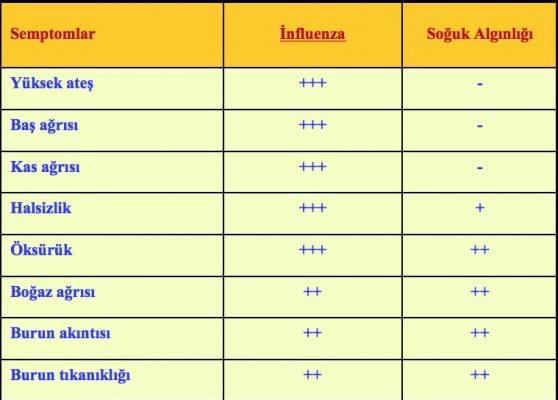Influenza is, in fact, a disease that should be taken seriously in all its forms. Not only swine flu but every type of flu can sometimes have a fatal course. When infected with swine flu, 3 out of 1000 individuals who feel quite unwell may result in death, and in general, 1 out of 10,000 cases can lead to mortality.
What is the Flu and Swine Flu?
The flu is a disease characterized by the infection of the respiratory tract (nose, throat, lungs) by influenza viruses. Unlike other respiratory viruses like the common cold, the flu is a serious illness and can lead to life-threatening complications in many individuals. Swine flu is caused by type A influenza viruses and, although it is considered a respiratory illness in pigs, it has been found to rarely infect humans.
Structure and Characteristics of the Influenza Virus:
The influenza virus causing the flu is an RNA virus from the Orthomyxoviridae family. There are three types of influenza viruses: A, B, and C. Types A and B can cause widespread epidemics, while type C is rare. Type A viruses have two surface antigens in the form of glycoproteins named Hemagglutinin (H) and Neuraminidase (N). So far, 18 hemagglutinin (H1-H18) and 9 neuraminidase (N1-N9) subtypes have been identified in the Influenza A virus.
How Does the Influenza Virus Spread and Cause Disease?
Influenza spreads when droplets released into the air during coughing, sneezing, or talking by infected individuals are inhaled through the mouth or nose of healthy individuals. It can spread up to 1.5-2 meters during coughing and sneezing. Additionally, touching surfaces contaminated with these particles and then touching the mouth or nose can also lead to transmission. The virus can survive on surfaces for up to 2 hours. Therefore, it is important to wash hands with soap and water.
How Long Does the Contagious Period Last?
The disease can be contagious one day before symptoms start and throughout the illness (approximately 7 days). In children, the contagious period can extend up to 10 days as the disease may sometimes last longer.
How Does the Flu Progress? Is It Fatal?
In healthy individuals, the flu often passes mildly, and recovery is observed within one week. However, in individuals with weakened immune systems, chronic diseases, heart-lung diseases, the elderly, diabetics, etc., serious and unwanted disease scenarios such as pneumonia, meningoencephalitis, myocarditis can occur, leading to complications and potential death.
Differences between influenza and cold:
How to Protect Against Influenza?
The vaccine is administered to adults as a single dose every year in the fall months (October-November) before the influenza season begins. The only situation where the vaccine should not be administered is a genuine egg allergy. The vaccine can be given during any trimester of pregnancy. For children aged 6-35 months, >3 years old children, and adults, it is recommended to administer the second dose one month after the first dose for children under 9 years old receiving the vaccine for the first time. It is recommended for everyone aged >6 months to continue routine annual influenza vaccination.
Who Should Get Vaccinated First?
- Children under 5 years old (especially <2 years)
- Adults over 65 years old
- Adults and children with chronic lung, cardiovascular, kidney, liver, blood, metabolic, or neurological diseases
- Individuals with immunosuppression (due to medication or HIV)
- Pregnant women or those within 2 weeks postpartum
- Children and adolescents taking long-term aspirin (6 months-18 years)
- Residents of nursing homes
- Extremely obese individuals
- Individuals living with or caring for high-risk individuals
- Healthcare workers
What Are the Side Effects of the Vaccine?
Since the vaccine contains inactivated viruses, there is no risk of causing the disease. Local pain, redness, and swelling typically resolve within 2 days. 3-4% may experience fever, weakness, muscle aches, and headaches starting 6-12 hours after the vaccine and lasting 3-4 days.
Can the Flu be Treated?
Antiviral treatment for seasonal flu is successful when initiated within the first 48 hours after symptoms begin, especially in severe cases. Treatment involves bed rest, isolation, and supportive care to reduce symptoms.
How Can We Protect Ourselves and Others from the Flu?
- Cover your mouth and nose with a tissue when coughing or sneezing; dispose of it afterward.
- Wash your hands frequently, especially after coughing or sneezing, with plenty of soap and water. Preferably use paper towels.
- If washing is not possible, use alcohol-based hand sanitizers.
- Avoid touching your eyes, nose, and mouth with dirty hands.
- Rest at home from the onset of symptoms until 7 days after they start, do not accept visitors, and wear a mask.
- Stay away from crowded places as much as possible.
- Ventilate the space you are in regularly.
Cover Image: Electron microscope image of the Swine Flu Virus. Used with permission from the U.S. Department of Health and Human Services, Centers for Disease Control and Prevention.

